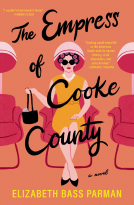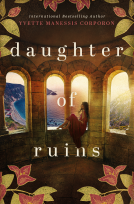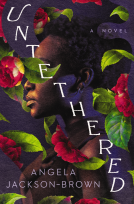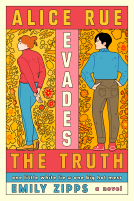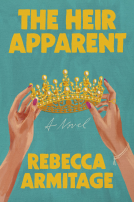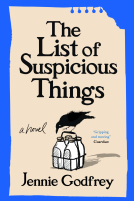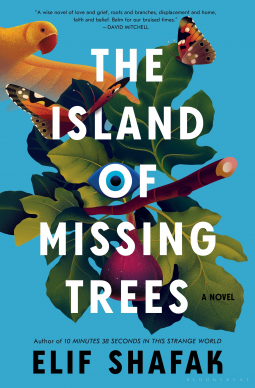
The Island of Missing Trees
A Novel
by Elif Shafak
This title was previously available on NetGalley and is now archived.
Send NetGalley books directly to your Kindle or Kindle app
1
To read on a Kindle or Kindle app, please add kindle@netgalley.com as an approved email address to receive files in your Amazon account. Click here for step-by-step instructions.
2
Also find your Kindle email address within your Amazon account, and enter it here.
Pub Date Nov 02 2021 | Archive Date Oct 31 2021
Bloomsbury USA | Bloomsbury Publishing
Talking about this book? Use #TheIslandofMissingTrees #NetGalley. More hashtag tips!
Description
A REESE'S BOOK CLUB PICK
Winner of the 2022 BookTube Silver Medal in Fiction * Shortlisted for the Women's Prize for Fiction
"A wise novel of love and grief, roots and branches, displacement and home, faith and belief. Balm for our bruised times." -David Mitchell, author of Utopia Avenue
A rich, magical new novel on belonging and identity, love and trauma, nature and renewal, from the Booker-shortlisted author of 10 Minutes 38 Seconds in This Strange World.
Two teenagers, a Greek Cypriot and a Turkish Cypriot, meet at a taverna on the island they both call home. In the taverna, hidden beneath garlands of garlic, chili peppers and creeping honeysuckle, Kostas and Defne grow in their forbidden love for each other. A fig tree stretches through a cavity in the roof, and this tree bears witness to their hushed, happy meetings and eventually, to their silent, surreptitious departures. The tree is there when war breaks out, when the capital is reduced to ashes and rubble, and when the teenagers vanish. Decades later, Kostas returns. He is a botanist looking for native species, but really, he's searching for lost love.
Years later a Ficus carica grows in the back garden of a house in London where Ada Kazantzakis lives. This tree is her only connection to an island she has never visited--- her only connection to her family's troubled history and her complex identity as she seeks to untangle years of secrets to find her place in the world.
A moving, beautifully written, and delicately constructed story of love, division, transcendence, history, and eco-consciousness, The Island of Missing Trees is Elif Shafak's best work yet.
Available Editions
| EDITION | Other Format |
| ISBN | 9781635578591 |
| PRICE | $27.00 (USD) |
| PAGES | 368 |
Links
Average rating from 75 members
Featured Reviews
The Island of Missing Trees is a magnificent story about love, loss, identity, and nature.
Set in 1974 Cyprus, the country is in turmoil between the two religious groups on the island. Despite the danger it presents, Kostas, a Greek Cypriot, and Defne, a Turkish Cypriot, are young and in love at a time when there is a lot of turmoil between the two groups living on the island. The only place safe for the two to meet is at a tavern called The Happy Fig. The Happy Fig gets its name from a fig tree planted in the centre. This tree remembers everything that goes on in the tavern. The tree remembers the lover’s secret meetings, war breaking out, and what came after.
Fast forward to present-day London, Ada is grieving from the death of her mother. She feels that she can’t open up to Kostas, her father, because he is always buried in his work and talking to the fig tree in their backyard. Ada’s parents raised her in an English-speaking household and have never revealed much about their life in Cyprus. With the help of her visiting aunt, she begins to learn what her parents have left unsaid and discover her identity.
This story has beautiful and lyrical prose with a sprinkle of magical realism. It’s told from the perspectives of Ada, Kostas, and the fig tree. The chapters are short, making this easy to fly through, even though I didn’t want it to end. There is also a helpful glossary of terms.
It explores the harsh realities of war on civilians, the resulting traumas, and ways to heal from it.
I forgot to mention that there’s also a talking parrot. This is the second book I’ve read this month that had one. I see a trend and, authors, I would like all future novels to have one too, please.
This was my first Elif Shafak novel, but it will in no way be my last.
Thank you to Bloomsbury Publishing for the arc via Netgalley in exchange for an honest review.
For more book reviews, see my blog: https://booksandwheels.com/blog/
 Reviewer 328937
Reviewer 328937
The Island of Missing Trees revolves around a couple who met in Cyprus shortly before the 1974 Cypriot civil war.
In a nutshell: Cyprus is an island in the Mediterranean Sea with a long history of being occupied or administered by different countries. In modern times, Cyprus was under the dominion of the British Empire from 1878 to 1960, when the island became independent. At that time, Cyprus was largely populated by Greek Cypriots and Turkish Cypriots, each of whom considered the island to be part of their home country.
To broker peace, the Zurich Agreement of 1960 recognized the equality and autonomy of the Greek and Turkish communities, which would be politically and culturally separate. Nevertheless, continuing conflict led to a 1974 civil war that (essentially) divided the country into 'Turkish Cyprus' in the north and 'Greek Cyprus' in the south. A romance between a Greek boy and a Turkish girl would be excoriated by both communities, and that's the conflict at the center of this gorgeous novel.
The story rotates among three time periods: 1974; the early 2010s, and the late 2010s.
⦿ 1974: Two teenagers in Nicosia, Cyprus - a Christian Greek boy named Kostas and a Muslim Turkish girl called Defne - are in love. They can't be seen together, so they meet in the back room of a taverna called The Happy Fig. The popular hangout is run by two men, Greek Cypriot Yiorgos and Turkish Cypriot Yusuf, who are sympathetic to the young couple's plight.
The Happy Fig is an ethnic eatery, described as follows: "The entrance of the tavern was partially covered with twisting vines of honeysuckle. Inside, solid black beams ran the length and breadth of the ceiling, from which hung garlands of garlic, onion, drying herbs, chili peppers and cured sausages. There were twenty-two tables....and a charcoal grill at the back from which the smell of flatbread wafted daily, along with the enticing aromas of cooking meats." To add to the taverna's ambiance, a Ficus carica (fig tree) sat in the middle of the dining area, growing through a cavity in the roof, and a resident parrot called Chico landed on people's shoulders and tried to snatch their food.
On their first evening at The Happy Fig, Kostas and Defne could afford nothing more than water, but the taverna's owners sent a tray with stuffed vine leaves, shrimp saganaki, chicken souvlaki with tsatziki sauce, moussaka, and pitta bread.
The happy young couple enjoyed every mouthful....and the Ficus watched it all. The fig tree is actually one of the book's narrators, and its long life, ability to converse with birds and insects, powers of observation, and intellect make it uniquely knowledgeable and articulate.
Though Kostas and Defne were only dimly aware of it, there was big trouble on the horizon, spurred by deep divisions between Greeks and Turks, rising unrest, and increasing terrorism.
*****
⦿ Early 2010s: The Committee on Missing Persons (CMP) is digging up sites in Cyprus, looking for the remains of people killed in the 1974 civil war. Thousands of people, both Greeks and Turks, are unaccounted for, and the teams searching for them are composed of archaeologists, anthropologists, historians, geneticists, forensic specialists, and others. The CMP works from information supplied by anonymous informants, and is hoping to reunite the deceased with their families.
A CMP searcher observes, "Sometimes you search for weeks on end and achieve nothing. It's frustrating. Some of the informants misremember the details, others deliberately lead us on wild goose chases. You search for victims, you encounter medieval, Roman, Hellenistic bones. Or prehistoric fossils....Then, just when you think you are going nowhere, you find mass graves." Explaining the need to hurry, the worker goes on, "The older generation is dying, taking their secrets with them to the grave. If we don't dig now, in a decade or so there won't be anyone left to tell us the whereabouts of the missing. It's a race against time, really.'
The CMP workers go on to discuss similar searches in Spain, Argentina, Chile and other countries that experienced internal conflict - and the stories are heart-wrenching.
*****
⦿ Late 2010s: Kostas and his teenage daughter Ada are living in London, mourning the recent death of Defne. Kostas, engulfed by grief over the loss of his wife, throws himself into his work - researching and writing about plants, animals, nature and ecosystems.
Kostas seems most comfortable with his fig tree, grown from a cutting of the fig tree in The Happy Fig taverna. Kostas talks to his fig tree, and the tree talks back....but Kostas can't hear it. In fact the the fig tree is quite loquacious. For instance, one winter afternoon the tree hears a bird and muses, "Inside the hedge a whitethroat began to sing - swift, scratchy notes. I wondered what a North African warbler was doing in our garden at this time of year. Why hadn't it left for warmer places with all the others that must now be on their way south, and who, if they made a slight change in their flight path, might just as well head towards Cyprus and visit my motherland."
As for Ada, she's overwhelmed by the loss of her mother, feels shut out by her father, and has problems concentrating at school. Ada experiences an additional emptiness because her parents never talked about Cyprus and she's never met any of her Cypriot relatives. Kostas and Defne wanted Ada to feel English, but the teen feels a pull toward Cyprus, a sort of epigenetic longing.
Nevertheless, when Defne's sister, Aunt Meryem, comes to London for a visit, Ada's first instinct is to be standoffish and distant. In large part, this is because Meryem didn't come to Defne's funeral, and Ada is angry at Meryem and all the other Cypriot relatives.
Like many Cypriot islanders, Meryem is deeply superstitious. On her first night in London, Meryem does a ritual for the dead near Kostas's fig tree, to guide Defne's spirit to safety. The tree, who's seen it all before, muses, "Humans have always sensed there was something uncanny about me and my kind....In Judaism, sitting under a fig tree has long been associated with a deep, devout study of the Torah....The Prophet Mohammed said the fig was the one tree that he wished to see in paradise....It was while meditating under a Ficus religiosa that Buddha attained enlightenment....and King David was fond of us." The Ficus goes on and on like this, explaining how special its kind are. (This is one smart fig tree!! 🙂)
Meryem's visit does give Ada the opportunity to ask questions about Cyprus, and Meryem reveals some surprising truths about Ada's parents and their families. Meryem also likes to cook, and tells Ada, "Food is the heart of a culture. You don't know your ancestors' cuisine, you don't know who you are." Then Meryem goes on to extoll the virtues of Turkish baklava, saying, "Everyone makes baklava, true, but not everyone succeeds. We Turks make it crispy with roasted pistachios. That's the right way. Greeks use raw walnuts - God knows who gave them that idea, it just ruins the taste."
In many ways, Kostas is the most sensitive character in the book, with his deep love of nature and his pain at its destruction. Kostas doesn't believe humans have the right to exploit everything in the world, which makes him something of an outlier. For example, one day young Kostas is watching his mother preserving songbirds (a Cypriot delicacy), opening their breasts with her thumbs and stuffing them with salt and spices. A wave of nausea overcomes the boy, and crying, he says, "Don't do that, Mama. I don't want to eat them anymore." Years later, Kostas tries to interfere with songbird poachers, which doesn't work out too well for him.
I like historic novels that enlighten me, and this one has bits about Greek customs; Turkish culture; the history of Cyprus; Greek mythology; and much more. The novel is also filled with beautiful word pictures, exemplified by one of the London fig tree's memories of Cyprus: "Of the past we left behind I remember everything. Coastlines etched in the sandy terrain like creases in a palm waiting to be read, the chorus of cicadas against the rising heat, bees buzzing over lavender fields, butterflies stretching their wings at the first promise of light.....many may try, but no one does optimism better than butterflies."
This is a memorable story with an unexpected (and very nifty) ending. Highly recommended.
FYI: At the end of the book, Elif Shafak describes how she researched the book, and includes a bibliography. Shafak also provides a glossary of foreign phrases, such as: abla - older sister (Turkish); ambelopoulia - a dish of grilled, fried, pickled, or boiled songbirds (Greek); kardoula mou - my little heart (Greek); majnun - a crazy person (Arabic); nazar - evil eye (Turkish); and many more.
Thanks to Netgalley, Elif Shafak, and Bloomsbury Publishing for a copy of the book.
 Reviewer 771928
Reviewer 771928
This is a perfect love letter to fig trees… I know it’s about love, loss, hatred, persistence, war, peace, tradition, religion, humanism, and humanity. Having a grandparent who went through the same loss on an island bit north of Cyprus due to conflicts created by people who could be the only ones benefitting from pitting people against each other, I know about what it means to have a crush on that Greek girl on the other street many many years again and introducing the granddaughter to now 70 something year old lady. Yet this is still a love letter to fig trees for me.
Defne and Kostas were young and in love, but they know the lines that are drawn everywhere else in the world were drawn for them too. (Don’t @ me, because it doesn’t matter how younger generations that took matters into their hands and stopped asking their parents’ permission; those families still secretly wish that their kids are partnered up with their countryman/woman.) Cyprus they know was about to go into flames along with their childhood and near future, but what was meant to happen would happen even years later.
At the end Elif Şafak talks about what she would hide in her luggage if she had known that she wasn’t coming back home and it got me thinking what would I bring in my luggage if I know that I’m going to spends months, sometimes years without setting a foot on home soil: I think I would bring a fig sapling (and maybe her little sister olive’s sapling too). I found so much about the people I know and myself in their book. If you are a Mediterranean kid or love a hopeless yet hopeful stories, you will love this book
After reading 10 Minutes 38 Seconds in this Strange World earlier this year, I immediately added The Island of Missing Trees to my list. And not surprisingly, it is absolutely stunning.
•
•
Shortly after her mother’s death, Ada has a breakdown in class and screams until she runs out of breath. Her parents emigrated from Cyprus and now that her mother has passed away, Ada is alone in London now with her dad until her aunt comes to visit.
When the narrative switches, Ada’s parents are introduced in 1974 Cyprus in a modern day Romeo and Juliet scenario where Greek and Turkish Cypriots shouldn’t interact. In a country still divided, they met and fell in love in the Happy Fig tavern. Central to the tavern is a fig tree growing up through the center and up through the roof, witnessing everything on the island including young love.
If you haven’t experienced Shafak’s beautiful prose, this novel will hook you on her writing. Simultaneously ethereal and down to earth, difficult subjects were handled with sensitivity and lightness of touch. It’s a story of love, conflict, suffering and hope. It’s powerful, profound, and moving. A truly beautiful read.
•
•
⭐️⭐️⭐️⭐️⭐️
 Alli F, Reviewer
Alli F, Reviewer
Elif Shafak's writing never ceases to amaze me. This story had me captivated from the first few pages, although it did take me a bit into the book to realize the headlines were the points of view changes, and yes - one of them was from the point of view of the fig tree.
It was beautiful, and I found myself having to put it down to digest the chapters I read, only to pick it up again the next day and be swept away.
Thank you to the author, publisher, and Netgalley for an ARC in exchange for an honest review.
 Summer H, Educator
Summer H, Educator
My first time to read anything by this author but I cannot wait to read more! This book was so interesting and I loved the character development. Please do yourself a favor and read this book!!
 Brianna F, Reviewer
Brianna F, Reviewer
Elif Shafak never let's me down. Of course, I had to put this down multiple times due to it's heaviness (in true Shafak fashion) so it took me longer than a usual read to complete. That being said, Shafak is always such a poet and I'm constantly struck by her way with words.
This one did take a little bit more time for me to really sink my teeth into and get a good feel regarding what this story was about, but it is so worth taking the time to settle in. Please, please, please pick this up.
Thank you to NetGalley for an ARC in exchange for an honest review.
 Peggy W, Reviewer
Peggy W, Reviewer
This is the story of war, of a couple in love separated, of a young girl Ada carrying the sadness of her family, of a gentle gay couple killed, and more—all narrated in part by a fig tree. And who would have known that a tree could be an amazing storyteller.
If you’ve ever fallen in love with a book, that is what happened to me when I read this one! It is an incredible read with elements of war, a heart wrenching love story, complicated parent/child relationships, and the story of a young girl gathering the history of her family and her developing “self”. I thought it was a creative, innovative masterpiece. There were so many sentences that made me think and appreciate the plant kingdom even more. And sentences, long and short, which I loved. For example, this one rings true for women’s rights--“women mourn, men replace.” It will lift your spirit and encourage your soul.
This book is why I love reading authors from outside my country and experience, and Elif Sharif is one of the best. Not only does her writing sing, I learn so much when I read her. (I started to take breaks to fact-check. She was 100%, so I stopped doubting.) In this work I discovered a Cyprus that is split by a demarcation line, that people bury fig trees in the winter, and much more.
This is a story about the Green Line, the partition that cuts through Cyprus, aiming to separate Greeks from Turks, Christians from Muslims - and a couple that dared to cross it. Not only cross the line, but find and keep love despite their difficulties and differences. While the line separates two groups, their history and future are together. As she said, “Greeks and Turks are flesh and fingernail.”
The story arches from Cyprus in the 70’s to London in 2010 and is told from three points of view. Kosta tells a good bit of the history of his life, love affair with Defne, their families, and the island. He is a wonderful, gentle character and I immediately warmed to him. The other two are his daughter, Ada - a shy and tortured teen living in London, and a fig tree brought from Cyprus as a cutting who shares interesting details about flora, fauna, and how people connect to them. Ada is the product of a marriage between a Turk and a Greek and the tree was lovingly cared for in Cyprus by a Turk/Greek couple. These two characters arrived in England together and their lives are completely intertwined.
And how talented must an author be to make a fig tree one of the main characters? (I think of Death in The Book Thief by Zusak or the house in The Dutch House by Patchett.) This is a feat all unto its own. The tree’s point of view is so interesting. It speaks to the need for all to be a part of the earth and a call for humans to come back to nature and stop ravaging it. I adored the figs interaction with ants, butterflies, a parrot, and other animals. The words his mouse friend chewed through and shared with seemed particularly appropriate as a 9 word summary of the book, “Some day this pain will be useful to you.”
There is love, loss, determination, pain, and hope wrapped up in this beautiful book. Thank you to NetGalley and Bloomsbury Publishing for providing an ARC in exchange for an honest review.
Special thanks to NetGalley Bloomsbury and Bloomsbury Publishing for the ARC of this book in exchange for my honest opinion.
I love, love, loved this book. Elif Shafak, the author, certainly knows how to weave a beautiful tale filled with history and magic. Narrated by the central part of this book, a fig tree, its a beautiful story of love, pain, and quite a few characters . The story is partly about Ada, daughter of Defne and Kostas, forbidden lovers because of different cultures, a Greek Christian and a Turkish Muslim, who meet in the 70's in Cyprus at a pub with a fig tree growing inside, who is witness to their invincible love story.
Fast forward to England, 2010, where their daughter Ada is dealing with the loss of her mother Defne and her father Kostas , who is lost in grief and all she has is the fig tree in her backyard, which was taken partly from the fig tree from the pub in Cyprus and grown in her backyard in London that holds all the secrets inside to the story of Defne and Kostas.
What a beautiful book and a beautiful story of magic realism and narrated by the fig tree.
Easily 5 stars!
 Cheri S, Reviewer
Cheri S, Reviewer
’It will have blood: They say blood will have blood. Stones have been known to move and trees to speak…’
-- William Shakespeare, Macbeth
A story of life and death, love and loathing, the seductive power of beauty, the destructive power of cruelty, and the healing nature of love and laughter.
This begins in England, momentarily leaving it to return to the beginning of this story, shared in this brief moment by a Ficus carica, a common fig who shares the indignity of being called ’common’ in any sense, memories of the past, the proud history of its adaptation across the world as they were carried across the globe. The narration of this story is shared by others as the story continues, returning periodically to the viewpoints of this tree who has seen and heard so much throughout its lifetime.
This is the first time I have read this author, and I was completely bewitched by this story, the way she weaves the stories of individuals who only briefly appear, looking deep inside these people for their truths. Their pain that they do not share, and the love that they keep inside, hiding from it, as well. Their joys and their fears.
Ada is at the forefront as this begins in London in 2010, a 16-year-old who has recently lost her mother, Defne. Her father, Kostas, lost in his own sorrow, can’t seem to reach her to help her navigate her grief. Her pain is tangible, and one day while in school, her pain is released in one long, piercing scream that is captured on a classmate’s cell phone, shared online, and goes viral. Now she is humiliated in addition to her pain.
In their garden grows a Ficus carica, it is the only physical connection Ada has to a history she knows little about, to the mother that she has lost, to the island where they met, and their story, which she knows little about. Secrets kept from her, if not intentionally. This tree carries those secrets inside.
Tackling the cultural differences that divided Cyprus in the 1970s, it also shares the story of Kostas and Defne, how they met, and continue to embrace a relationship, one that must remain hidden. They meet secretly at The Happy Fig, a café with a fig tree growing inside, which is also home to Chico, a parrot. It is a love that must remain hidden to their families, their differences that are at the heart of the cultural divide. One a Greek Christian, the other a Turkish Muslim. But love never takes such things into account, love insists on defying boundaries, the very nature of love lies in its belief it is invincible.
Pub Date: 02 Nov 2021
Many thanks for the ARC provided by Bloomsbury USA, Bloomsbury Publishing
 Elyse W, Reviewer
Elyse W, Reviewer
Elif Shafak is a great storyteller…..a very skillful writer. I’m a fan!
….I loved the ‘very’ start/introduction with an excerpt by William Shakespeare:
“To immigrants and exiles everywhere, the uprooted, the re-rooted, the rootless,
And to the trees we left behind, rooted in our memories….”
“Anyone who hasn’t been in the Chilean forest doesn’t know this planet. I have come out of that landscape, that mud, that silence, to roam, to go singing through the world”.
—Pablo Neruda, Memoirs
“It will have blood: They say blue head will have bled. Stones have been known to move and trees to speak…
— William Shakespeare, Macbeth
I also loved the beginning contextual quotes. (I felt it was a great way to set up readers. I was excited to dive into the main meal:
“Once upon a memory, at the far end of the Mediterranean Sea, there lay an island so beautiful and blue that the many travelers, pilgrims, crusaders and merchants who fell in love with it either wanted never to leave or try to tow it with hemp ropes all the way back to their own countries”.
“Legends, perhaps.
But legends are there to tell us what history has forgotten. It has been many years since I fled that place on board a plane, inside a suitcase made of soft black leather, never to return. I have since adopted another land, England, where I have grown and thrived, but not a single day passes that I do not yearn to be back. Home. Motherland”.
“The Mediterranean sea will collapse on itself and its secret will rise to the surface, as every secret is bound to do in the end”.
After the beautiful introduction we move into the first chapter.
…..We meet Ada Kazantzakis, sixteen years old at the start - in London. It’s the late 2010’s
She was sitting in class. The bells were about to ring for the Christmas holidays.
Everyone was concerned about a big storm coming that was expected to paralyze large swathes of England and Scotland and parts of northern Europe. People had been stockpiling, getting ready for the siege.
We learn that Ada’s father, Kostas, an evolutionary ecologist and botanist, had published twelve books — he wrote and spoke about the impact of deforestation with a passion.
Since the death of Ada’s mother -(a little less than a year ago) her father had retreated into research “like a burrowing animal hiding in its tunnel for safety and warmth”.
“No matter the time of day, her father seemed to prefer the company of trees to the company of humans”.
GREAT SET UP ….I was still very interested….
But something also felt ‘off’…..
… [note: for me this was the only boo-boo, I didn’t feel fit]..
Just before Ada’s teacher, Mrs. Walcott dismissed the class for the Christmas holiday break— she gave the students an assignment.
They were to interview an elderly relative during the holidays. The teacher told them to support their five page essay with historical facts. She didn’t want speculation.
Ada had never met her relatives but she knew that they lived on an island in The Mediterranean Sea-in Cyprus.
Her relatives and the island with both mysteries to Ada.
ALL GOOD…clear!….I was still excited to dive into this novel.
But…
…..then….
THIS happened ….(I found it disturbing and puzzling):
A boo boo: (in my opinion).
Ada imagined her teacher touching herself at night.
It didn’t feel fitting with ‘anything’. It was so surprising to me. I found ‘nothing’ that warranted this to be included in this story.
Plus, it was too fast and too soon to drop a sexual visual fantasy - about Ada’s teachers private life. I would have omitted it altogether.
We moved from the classroom to the next chapter called: “Fig Tree”….
I was at 9% of this story.
I ‘began’ to understand what was going on with the styling, crafting, and storytelling.
It’s bathed in lyrical magical realism.
The narrative switches back-and-forth from present day - 2010 to the past of 1974 when Ada’s parents - Kostas and Defne (Christian Greek and Turkish Muslim), were secretly dating, knowing their families would not approve of their relationship.
Kostas and Defne’s secret meeting place was in ‘The Happy Fig’ tavern in Cyprus. The tavern was a happening spot for
Greeks, Turks, Armenians, Maronites, and UN soldiers.
The eco consciousness of The Fig Tree was powerful: [The fig Tree is one of the narrators]….
Example of The Fig Tree’s voice:
“When you are buried, I’ll come and talk to you every day, Kostas said as he drove the spade into the ground. He bore down on the handle and lifted up the clod of soil, tossing it on to the growing mound beside him. You won’t feel lonely”.
“I wish I could have told him that loneliness is a human invention. Trees are never lonely. Humans think they know with certainty where their being ends and where someone else’s starts. With their roots tangled and caught up underground, linked to a fungi and bacteria, trees harbour no such illusion. For us, everything is interconnected”.
In the authors notes Elif wrote that many of the stories of the missing mentioned throughout the novel were based on real accounts. The story is fiction, but inspired by many real accounts. We learn about the fraught and unsettling history—(torn apart by war over religion divisions), the island became a matter of disagreement between two prominent ethnic communities: Greek Cypriots and Turkish Cypriots.
“History has warned about the between humaninduced carbon emissions and rising temperatures”
Elif says….
“I also wanted to honour local folklore and oral traditions. But everything here is fiction
— a mixture of wonder, dreams, love, sorrow and imagination”.
It takes a little concentration and patience….to fully appreciate the magnitude of this novel. ….but it’s more than worth it.
Many sentences and paragraphs are not only beautifully written - but they are profoundly discerning and perceptive.
Elif Shafak gently exposes the depths of war, conflict, love, loss, trauma, migration, segregation, pain and suffering….connecting our human world with our root-plant world.
“Plants can pick up vibrations, and many flowers are shaped like balls so as to better trap sound waves, some of which are too high for the human ear. Trees are full of songs and we are not shy to seeing them”.
“I listen carefully, and I find it astounding that trees, just through their presence, become a saviour for the downtrodden and symbol of suffering for people on opposite sides”.
“Across history we have been a refuge to a great many. A sanctuary not only for mortal humans, but also for gods and goddesses. There is a reason why Gaia, the mother goddess earth, turned her son into a fig tree to save him from Jupiter’s thunderbolts. In various parts of the world, women thought to be cursed and married to a Ficus carica before they can pledge their troth to the one they truly love”.
“Ever since Kostas was a boy, trees had offered him solace,
a sanctuary of his own, and he had perceived life through the colors and density of their boughs and foliage. Yet his profound admiration for plants had also afflicted him with a strange sense of guilt, as if by paying this much attention to nature he was neglecting something if not more crucial then at least as urgent and compelling — human suffering. Much as he loved the arboreal world and it’s complex ecosystem, was he, in some roundabout way, avoiding the day-to-day realities of politics and conflict? A part of him understood that people, especially where he came from, might see it this way, but a bigger part of him seriously rejected the idea.
He had always believed there was no hierarchy — or there should be none — between human pain and animal pain, and no precedence of human rights over animal rights, or indeed of human rights over those of plants, for that matter. He knew many among his fellow countrymen I would be deeply offended if he voiced this out loud”.
There are pages and pages of delicious moments…..
Here is one more…( put a sweet smile on my face):
“Defne was gone but Ada was here.
Kostas was worried that he was failing her. He had been withdrawn and taciturn this past year, a cloud of lethargy looming over everything he said and couldn’t say”.
They had been so close once, he and Ada. Like a bird imbuing each tale with suspense, he would tell her about night-blooming chocolate flowers, slowgrowing lithops — flowering stones — that strangely resembled pebbles, and Mimosa pudica, a plant so shy it would shrink away at the slightest touch. It warmed his heart to see his daughter’s endless fascination with nature; he would always patiently answer her questions. Back then, such was the strength of their bond that Defne, only half jokingly, would complain: ‘I’m jealous. See how Ada listens to you! She admires you, darling’”.
The symbolic relationship between humans and plants take several forms. Plants help humans breathe by providing us with oxygen, and humans help plants breathe by providing them with carbon dioxide….
It’s a relationship made from love.💕🌳
Congrats to Elif Shafak…. a beautiful novel indeed!
Thank you Netgalley, Bloomsbury Publishing…and Elif Shafak
4.99 rating
 Reviewer 304554
Reviewer 304554
Thank you to NetGalley and Bloomsbury USA for the opportunity to read this ARC in exchange for a review.
Add this to your TBR list. Coming Nov. 2. Love! Love!! Love!!! The language and detail is entrancing. I didn't want the book to end.
Kostas and Defne are teens when they meet on the island of Cypress in 1974. However they have to meet in secret because he is a Christian Greek and she is a Turkish Muslim. They two meet in the back room of a Tavern, The Happy Fig. It is owned by two men, one Greek and one Turk, so they understand the lovers plight. As political tensions rise and the threat of war eminent, Kostas' mother sends him away to live with family in London. Twenty-five years later he returns under the guise of botanical research but in his heart he is there for Defne.
Throughout the book the fig tree from the tavern provides narrative for not only the lovers but for the history of their story, the island, the supporting characters and of nature. An ecological eye-opener of how trees, plants, animals and insects exist without the world noticing.
This story is about love and loss, trauma and healing, understanding and forgiveness. A must read!
Readers who liked this book also liked:
Yvette Manessis Corporon
General Fiction (Adult), Historical Fiction, Women's Fiction
